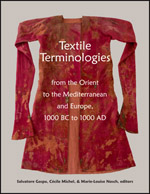Center, Textile Research

Textile Terminologies from the Orient to the Mediterranean and Europe, 1000 BC to 1000 AD
Date of this Version
2017
Document Type
Article
Citation
In Textile Terminologies from the Orient to the Mediterranean and Europe, 1000 BC to 1000 AD, ed. Salvatore Gaspa, Cécile Michel, & Marie-Louise Nosch (Lincoln, NE: Zea Books, 2017), pp. 47-90.
doi:10.13014/K27S7KXZ
Abstract
At its political and territorial apex in the 8th and 7th centuries BC, Assyria developed into an imperial society characterised by the coexistence of languages and cultures of various origins. The policy of deporting and resettling conquered peoples across the Empire’s territory caused the spread of the Aramaic language and alphabetic script as well as the use of Aramaic as a co-official language alongside Akkadian. The linguistic change caused by these events in the Empire’s core territory emerges from the late stage of the Assyrian dialect, which shows the impact of Aramaic on various grammatical and lexical elements of the language. At the same time, Neo-Assyrian maintained continuous contact with the Neo- Babylonian dialect, the language spoken by numerous individuals employed in the state sector as scribes, scholars, and officials.
The study of the lexicon of material culture may reveal how these social and linguistic changes shaped the everyday language that emerges from Neo-Assyrian letters, administrative records, and legal documents. For the terminology of textiles, it is interesting to observe the coexistence of terms belonging to the common Akkadian textile terminology with designations that are peculiar to the late dialects of Akkadian (1st millennium BC), namely Neo-Assyrian and Neo-Babylonian. Other terms, which are genuinely Assyrian, show continuity across the Middle Assyrian and Neo-Assyrian periods. A West Semitic component of the Neo-Assyrian textile terminology is also evident, along with terms possibly belonging to the Hurrian substratum, presumably inherited from the Middle Assyrian dialect, and others of unknown origin.
Included in
Ancient History, Greek and Roman through Late Antiquity Commons, Art and Materials Conservation Commons, Classical Archaeology and Art History Commons, Classical Literature and Philology Commons, Fiber, Textile, and Weaving Arts Commons, Indo-European Linguistics and Philology Commons, Jewish Studies Commons, Museum Studies Commons, Near Eastern Languages and Societies Commons, Other History of Art, Architecture, and Archaeology Commons


Comments
Copyright © 2017 Salvatore Gaspa, Cécile Michel, & Marie-Louise Nosch. Photographs copyright as noted.